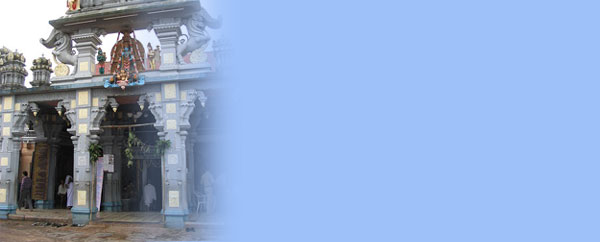Udupi (Karnataka)
In the 16th century during Sri Vaadiraja's
administration, Kanakadasa an ardent
believer of God came to Udupi to worship
Lord Krishna.
Udupi (Karnataka) Hindu Temples

Udupi is a city and the headquarters of the Udupi District in the Indian state of Karnataka. Udupi is famous for the Krishna temple located here. It also lends its name to the Udupi cuisine which is famous across the world.
Etymology
It is widely believed that the name of Udupi was derived from its Tulu name Odipu. The Tulu name in turn is associated with a temple at Malpe, devoted to Vadabhandeshwara. Another story is that the name Udupi came from the combination of the Sanskrit words Udu and Pa, which mean "stars" and "lord." According to legend, the moon's light was once reduced due to a curse by King Daksha, whose 27 daughters (the 27 stars, according to Hindu astrology) were married to the moon. The moon prayed to Lord Shiva to get back its original shine. Lord Shiva was pleased with the moon's prayer and restored its shine. Legend says that the moon and his wives made their prayer at the Chandramouleeshwara temple at Udupi, creating a linga that can be seen even today. According to this story, therefore, Udupi means the land of the "lord of the stars," the moon.
Religious significance
Udupi is known for the Krishna Mutt (Temple of Lord Krishna). The Krishna Mutt was founded by the Vaishnavite saint Shri Madhvacharya in the 13th century.
According to history, there were a storm in the sea at Malpe. Shri Madhvacharya was on the shore at the time and saw a ship which was in trouble. He helped the ship reach the shore to safety. The sailors were very grateful to him and gave him idols of Lord Krishna and Lord Balarama. He did the pratishte (installation ceremony) of the idol of Lord Balarama near Malpe. This temple is known as Vadabhandeshwara. He brought the idol of Lord Krishna and did the pratishte at Udupi. This temple is known as Krishna Mutt.
Shri Madhvacharya handed over the puja and administration of Krishna Mutt to his 8 disciples. Each of them set up their Mathas (monasteries) around the Krishna Mutt. These are known as the Ashta Mathas. The Mathas are Pejavara, Puttige, Palimaru, Adamaru, Sodhe, Kaniyooru, Shirur and Krishnapura. Since then, the daily sevas (offerings to god) and administration of the Krishna Mutt are managed by the Ashta Mathas (eight temples). Each of the Ashta Mathas performs temple management activities for two years in a cyclical order. During the Paryaya festival, held every two years, the temple management is handed over to the next Matha. Each of the Mathas is headed by a Swami, who will be in charge of the temple during his Paryaya.
In the 16th century during Sri Vaadiraja's administration, Kanakadasa an ardent believer of God came to Udupi to worship Lord Krishna. He was not allowed inside the temple since he was from a lower caste. He tried to see Lord Krishna from a small window, but was only able to see Lord Krishna from the back. It is believed that Sri Krishna, pleased by the bhakti (devotion) of Kanakadasa turned to face the window. This window came to be known as Kanakana Kindi. To this day, the idol of Lord Krishna faces the back of the temple towards the Kanakana Kindi. All Hindu temples have their Vigraha (idol of god) facing the entrance of the temple, except Krishna Mutt.
Kanakana Kindi is decorated with carvings depicting the ten incarnations of Vishnu. Through the nine small holes of the window we see the tiny icon of Sri Krishna as a very young boy. He holds the churning rod in His right hand and rope in his left. The Krishna Matha is known throughout the world for its religious customs, traditions, and learning in Dvaita or Tatvavaada philosophy. It is also the centre of Daasa Sahitya, a form of literature that originated in Udupi.
Another important festival is Bhajana Saptaha which is held in Sri Laxmi Venkatesh Temple. Saptaha means one week. During this time Bhajans are sung continuously day and night for 7 days. This falls during August of every year.
Other links
Hindu Temples in India
temples
Karnataka